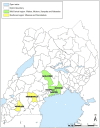A Survey of Priority Livestock Diseases and Laboratory Diagnostic Needs of Animal Health Professionals and Farmers in Uganda
- PMID: 34631853
- PMCID: PMC8494769
- DOI: 10.3389/fvets.2021.721800
A Survey of Priority Livestock Diseases and Laboratory Diagnostic Needs of Animal Health Professionals and Farmers in Uganda
Abstract
Background: Despite the investments made in veterinary diagnostic laboratory service delivery in Uganda, the scope and level of utilization remains low. This study aimed to determine the priority livestock diseases for which farmers and animal health professionals require veterinary diagnostic laboratory services, document the perceptions and opinions of key stakeholders on veterinary diagnostic laboratory services, and determine the factors that influence the delivery and utilization of animal disease diagnostic services in Uganda. Methods: A qualitative study approach involving a survey and key informant interviews was used to collect relevant data from four stakeholder groups: animal health workers, laboratory technologists and technicians, farmers, and key informants. The survey data were exported to excel, and descriptive statistics performed. The key informant interview recordings were transcribed, and thematic analysis performed. Results: The most reported diseases and conditions for which diagnostic services were needed were hemoparasites (including East Coast fever, anaplasmosis, babesiosis, and trypanosomosis), viral (including Foot and mouth disease, lumpy skin disease, rift valley fever, and papillomatosis), bacteria (including brucellosis, colibacillosis, anthrax, leptospirosis, and paratuberculosis) and protozoa diseases (coccidiosis), endoparasites (helminths), and mastitis. The most common diagnostic laboratory tests requested by clients, but laboratories were unable to provide included: rapid tests for contagious bovine pleuropneumonia, Foot and mouth disease, Newcastle disease, acaricide analysis, culture and antimicrobial sensitivity test, serology, and complete blood count. The most frequently reported challenges to providing diagnostic laboratory services were poor or lack of relevant equipment, insufficient or lack of supplies and reagents, high cost of reagents, inadequate or lack of laboratory staff to perform tests, and inadequate training of laboratory staff. Conclusions: This study highlighted the need to improve provision of laboratory diagnostic services to meet the prioritized diagnostic needs of farmers and animal health professionals. Increased intersectoral engagement and funding support from the private, industry, and government sectors is necessary to help address the observed challenges to provision of diagnostic laboratory services, including equipping of the laboratories, provision of supplies, and hiring and training of laboratory staff. Finally, the findings also suggest that the education of farmers and animal health workers on the value and benefits of laboratory diagnostic services may contribute to increase in sample submission and subsequent demand for diagnostic laboratory services.
Keywords: Uganda; animal health; diagnostics; laboratory; laboratory technologist; livestock; veterinary; veterinary professionals.
Copyright © 2021 Vudriko, Ekiri, Endacott, Williams, Gityamwi, Byaruhanga, Alafiatayo, Mijten, Tweyongyere, Varga and Cook.
Conflict of interest statement
EM and GV are employed by Zoetis and contributed to conception and report writing. The remaining authors declare that the research was conducted in the absence of any commercial or financial relationships that could be construed as a potential conflict of interest.
Figures









Similar articles
-
Management of diseases in a ruminant livestock production system: a participatory appraisal of the performance of veterinary services delivery, and utilization in Ghana.BMC Vet Res. 2023 Nov 15;19(1):237. doi: 10.1186/s12917-023-03793-z. BMC Vet Res. 2023. PMID: 37968624 Free PMC article.
-
Improving the delivery of veterinary services in Africa: insights from the empirical application of transaction costs theory in Uganda and Kenya.Rev Sci Tech. 2017 Apr;36(1):279-289. doi: 10.20506/rst.36.1.2628. Rev Sci Tech. 2017. PMID: 28926009 Review.
-
Continuing Education of Animal Health Professionals in Uganda: A Training Needs Assessment.J Vet Med Educ. 2022 Aug;49(4):503-514. doi: 10.3138/jvme-2020-0161. Epub 2021 Jun 11. J Vet Med Educ. 2022. PMID: 34077337
-
Irish dairy farmers' engagement with animal health surveillance services: Factors influencing sample submission.J Dairy Sci. 2020 Nov;103(11):10614-10627. doi: 10.3168/jds.2019-17889. Epub 2020 Aug 26. J Dairy Sci. 2020. PMID: 32861485
-
Synergies between veterinarians and para-professionals in the public and private sectors: organisational and institutional relationships that facilitate the process of privatising animal health services in developing countries.Rev Sci Tech. 2004 Apr;23(1):115-35; discussion 391-401. doi: 10.20506/rst.23.1.1472. Rev Sci Tech. 2004. PMID: 15200091 Review.
Cited by
-
Network Analysis of Small Ruminant Movements in Uganda: Implications for Control of Transboundary Animal Diseases.Transbound Emerg Dis. 2025 May 14;2025:7474495. doi: 10.1155/tbed/7474495. eCollection 2025. Transbound Emerg Dis. 2025. PMID: 40400717 Free PMC article.
-
Identifying target areas for risk-based surveillance and control of transboundary animal diseases: a seasonal analysis of slaughter and live-trade cattle movements in Uganda.Sci Rep. 2023 Oct 30;13(1):18619. doi: 10.1038/s41598-023-44518-4. Sci Rep. 2023. PMID: 37903814 Free PMC article.
-
The economic cost of bovine trypanosomosis in pastoral and ago pastoral communities surrounding Murchision Falls National park, Buliisa district, Uganda.BMC Vet Res. 2022 Oct 17;18(1):372. doi: 10.1186/s12917-022-03468-1. BMC Vet Res. 2022. PMID: 36253776 Free PMC article.
-
Comparative evaluation of rapid diagnostic test and PCR-based diagnostic assay for identification of trypanosomes in cattle of Apac and Kiryandongo districts, Uganda: A cross sectional study.BMC Vet Res. 2024 Dec 19;20(1):570. doi: 10.1186/s12917-024-04436-7. BMC Vet Res. 2024. PMID: 39696308 Free PMC article.
References
-
- Ocaido M, Otim CP, Okuna NM, Erume J, Ssekitto C, Wafula RZO, et al. . Socio-economic and livestock disease survey of agro-pastoral communities in Serere County, Soroti District, Uganda. Livest Res Rural Dev. (2005) 17:93. Retrieved from: http://www.lrrd.org/lrrd17/8/ocai17093.htm
LinkOut - more resources
Full Text Sources

